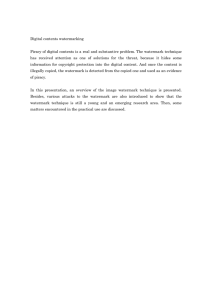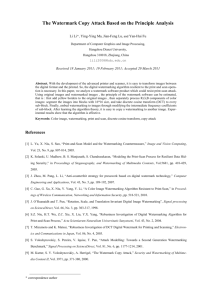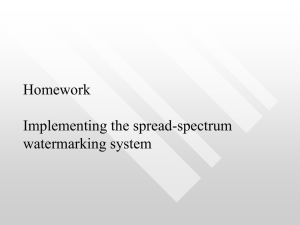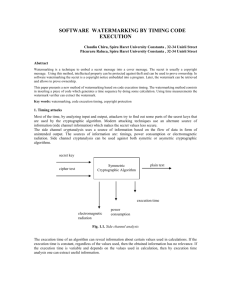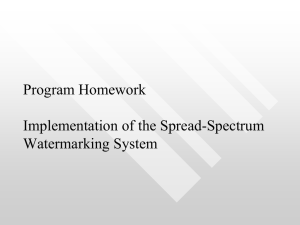Watermarking Of Images Using Hybrid Technique Web Site: www.ijaiem.org Email:
advertisement
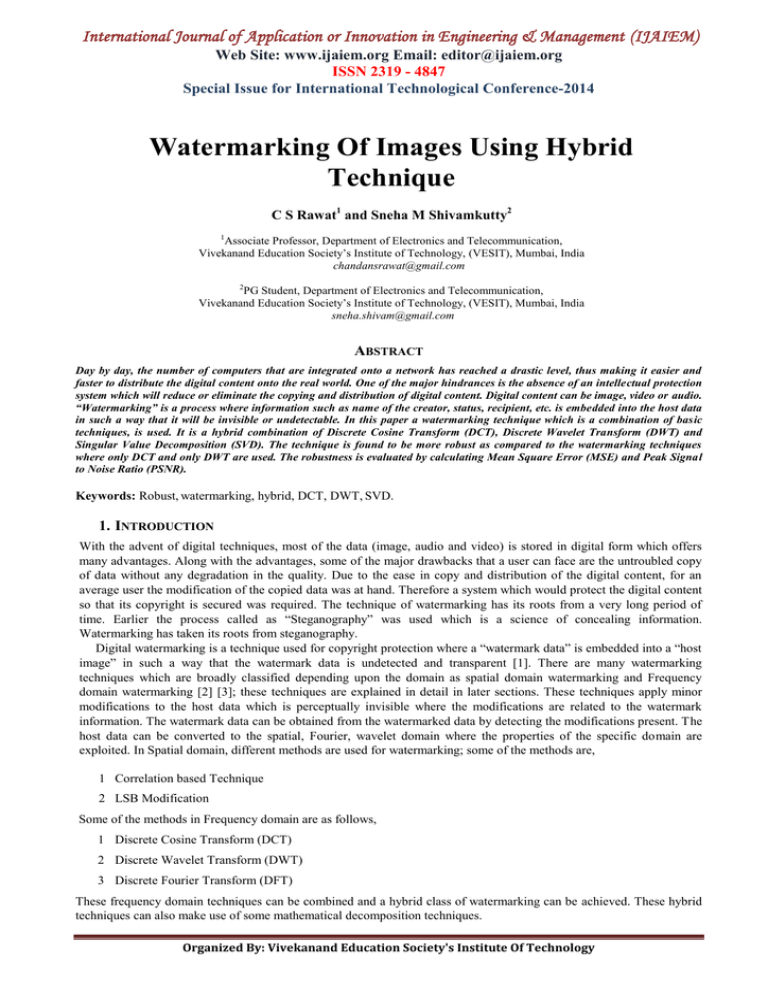
International Journal of Application or Innovation in Engineering & Management (IJAIEM)
Web Site: www.ijaiem.org Email: editor@ijaiem.org
ISSN 2319 - 4847
Special Issue for International Technological Conference-2014
Watermarking Of Images Using Hybrid
Technique
C S Rawat1 and Sneha M Shivamkutty2
1
Associate Professor, Department of Electronics and Telecommunication,
Vivekanand Education Society’s Institute of Technology, (VESIT), Mumbai, India
chandansrawat@gmail.com
2
PG Student, Department of Electronics and Telecommunication,
Vivekanand Education Society’s Institute of Technology, (VESIT), Mumbai, India
sneha.shivam@gmail.com
ABSTRACT
Day by day, the number of computers that are integrated onto a network has reached a drastic level, thus making it easier and
faster to distribute the digital content onto the real world. One of the major hindrances is the absence of an intellectual protection
system which will reduce or eliminate the copying and distribution of digital content. Digital content can be image, video or audio.
“Watermarking” is a process where information such as name of the creator, status, recipient, etc. is embedded into the host data
in such a way that it will be invisible or undetectable. In this paper a watermarking technique which is a combination of basic
techniques, is used. It is a hybrid combination of Discrete Cosine Transform (DCT), Discrete Wavelet Transform (DWT) and
Singular Value Decomposition (SVD). The technique is found to be more robust as compared to the watermarking techniques
where only DCT and only DWT are used. The robustness is evaluated by calculating Mean Square Error (MSE) and Peak Signal
to Noise Ratio (PSNR).
Keywords: Robust, watermarking, hybrid, DCT, DWT, SVD.
1. INTRODUCTION
With the advent of digital techniques, most of the data (image, audio and video) is stored in digital form which offers
many advantages. Along with the advantages, some of the major drawbacks that a user can face are the untroubled copy
of data without any degradation in the quality. Due to the ease in copy and distribution of the digital content, for an
average user the modification of the copied data was at hand. Therefore a system which would protect the digital content
so that its copyright is secured was required. The technique of watermarking has its roots from a very long period of
time. Earlier the process called as “Steganography” was used which is a science of concealing information.
Watermarking has taken its roots from steganography.
Digital watermarking is a technique used for copyright protection where a “watermark data” is embedded into a “host
image” in such a way that the watermark data is undetected and transparent [1]. There are many watermarking
techniques which are broadly classified depending upon the domain as spatial domain watermarking and Frequency
domain watermarking [2] [3]; these techniques are explained in detail in later sections. These techniques apply minor
modifications to the host data which is perceptually invisible where the modifications are related to the watermark
information. The watermark data can be obtained from the watermarked data by detecting the modifications present. The
host data can be converted to the spatial, Fourier, wavelet domain where the properties of the specific domain are
exploited. In Spatial domain, different methods are used for watermarking; some of the methods are,
1 Correlation based Technique
2 LSB Modification
Some of the methods in Frequency domain are as follows,
1 Discrete Cosine Transform (DCT)
2 Discrete Wavelet Transform (DWT)
3 Discrete Fourier Transform (DFT)
These frequency domain techniques can be combined and a hybrid class of watermarking can be achieved. These hybrid
techniques can also make use of some mathematical decomposition techniques.
Organized By: Vivekanand Education Society's Institute Of Technology
International Journal of Application or Innovation in Engineering & Management (IJAIEM)
Web Site: www.ijaiem.org Email: editor@ijaiem.org
ISSN 2319 - 4847
Special Issue for International Technological Conference-2014
Some of the methods are as follows.
1 DCT-DWT
2 DCT-DWT-SVD, where SVD is Singular Value Decomposition.
The different watermarking techniques are explained in section 2. Section 3 explains hybrid watermarking technique.
Algorithm for DCT-DWT-SVD is explained in section 4. Section 5 contains the experimental result followed by the
conclusion in section 6.
2. TYPES OF WATERMARKING
2.1 Spatial Domain Watermarking [2] [3]
In this technique, the watermark is embedded by modifying the pixel values of the host data directly. This technique
exploits the luminance component of the image. The embedding location is determined by calculating the blocks with
highest luminance. These selected blocks are the position where the watermark is embedded and the image is reconverted
to obtain the watermarked image. For the extraction both the original and watermarked image are compared to obtain the
encrypted watermark bit. Least significant bit modification technique is the most popular and common technique used. In
this method the watermark is embedded in the LSB of each pixel. It is the simplest method where the entire image is used
for embedding the watermark. Thus making it possible to embed smaller objects as watermark and that too multiple
times. Lower computations and simplicity are its advantages, along with the disadvantage of uncovering the watermark if
an attack is made on pixel to pixel basis. In Correlation based technique a pseudo random noise pattern is applied to the
image and the correlation between the noise pattern and the watermarked image is exploited. Many modifications have
been proposed and applied to these techniques thus making the technique more robust against various attacks [2].
2.2 Frequency Domain Watermarking [2] [3] [4]
In this technique, the host image is first converted into frequency domain by using suitable transformation techniques.
The transformation techniques are DCT, DWT and DFT. The coefficients of the transformed domain are changed to store
the watermark information and finally inverse transform is applied to recover the watermarked image. These techniques
distribute the watermark irregularly over the image pixels after the inverse transform thus making the detection and
manipulation of the watermark more difficult. These methods have the advantages of the properties of different domain
which compensates to the drawbacks of the pixel based techniques. The only drawbacks of these techniques are higher
computations as compared to the pixel based technique. These techniques are explained in the following sections.
2.2.1 Discrete Fourier Transform (DFT)
In this transform, the image is divided into two matrices one for amplitude and other for phase. Therefore when the
watermark is embedded in the phase matrix, the technique becomes more robust against various attacks. It is a complex
transform.
2.2.2 Discrete Cosine Transform (DCT)
DCT [5] [6] is very similar to DFT. Only difference is that in DCT the data is represented as frequency space rather than
amplitude space. This is very useful since it corresponds more to the way how human perceive light and the part which
are not perceived can be identified and discarded. The advantages are further improved if the watermark is embedded in
the perceptually significant portion of the image. Applying DCT, breaks the image into low, middle and high frequencies,
thus making the embedding into mid frequency band easy. The Two dimension DCT and inverse DCT equations for an
image of size M x N is given as follows in equation 1 and 2.
F (u, v) = α(u)α(v) ∑∑f ( x, y) cos{[(2 x + 1)u.π ] / 2M } cos{[(2 y + 1)v.π ] / 2 N}
(1)
f ( x, y) = ∑∑α(u)α(v) F (u, v) cos{[(2 x + 1)u.π ] / 2M }cos{[(2 y + 1)v.π ] / 2 N}
Where,
α(u) = 1 / M
(u) 2 / M
(v) 1/ N
(v) 2 / N
(2)
for u=0
for u =1,2,3....M-1;
for v =0;
for v =1,2,3....N-1;
x = 0,1,2,3.....M-1 and y = 0,1,2,3.....N-1
It is more robust as compared to the spatial domain watermarking. The drawback is that it is weak against certain
attacks such as rotation, scaling, cropping etc.
Organized By: Vivekanand Education Society's Institute Of Technology
International Journal of Application or Innovation in Engineering & Management (IJAIEM)
Web Site: www.ijaiem.org Email: editor@ijaiem.org
ISSN 2319 - 4847
Special Issue for International Technological Conference-2014
DWT first level decomposition
Figure 1 One level DWT
2.2.3 Discrete Wavelet Transform (DWT)
The technique which is used most widely nowadays for signal processing applications is DWT [7]. The energy of the
wavelets is concentrated in time and also these are well suited for analysis of time varying signals and transients. DWT
decomposes an image into sub images or sub bands, three details and one approximation. The bands are LL, LH, HL and
HH. Figure 1 above shows the sub bands in DWT. LL contains low frequencies both in horizontal and vertical direction.
HH contains high frequencies both in horizontal and vertical direction. HL contains high frequencies in horizontal
direction and low frequencies in vertical direction. LH contains low frequencies in horizontal direction and high
frequencies in vertical direction. The most significant band is LL which contains most of the image energy and it
represents the approximations of the image. High energy watermarks can be embedded in the regions that the human
vision is less sensitive to, these regions are the high resolution detail bands (LH, HL and HH). The robustness of the
watermark is increased by embedding into these bands without having additional impact on the quality of the image. The
advantage of this technique is that it has multi resolution characteristics. The human eyes are not sensitive to the small
changes in edges and textures of an image but are very sensitive to the small changes in the smooth parts of an image.
With the DWT, the edges and textures are usually to the high frequency sub bands, such as HH, LH, and HL etc. The
major drawback of this method is that the computational requirement is very high as compared to other methods.
3. HYBRID WATERMARKING
Each of these methods explained earlier has their own advantages and disadvantages. The three main characteristics that
a watermarking scheme should possess are robustness, capacity and imperceptibility [3]. There is no single technique
which can provide all these properties with maximum values. But one can achieve quite acceptable quality by combining
various watermarking algorithms. Many schemes have been proposed, of which one of the watermarking technique is a
combination of DCT and DWT. First and Second level DWT is applied to the host image and then the watermark is
embedded and then sub bands are selected. On the selected bands, DCT is applied. The combination of these two
transforms improved the watermarking performance considerably when compared to the DWT-only watermarking
approach.
Along with the frequency domain methods some of the mathematical transformation techniques are used for
decomposition. Some of the techniques are,
Singular Value Decomposition (SVD)
Principal Component Analysis (PCA)
3.1 Singular Value Decomposition (SVD)
The singular value decomposition (SVD) [4] is a decomposition or factorization of a rectangular real or complex matrix,
used in linear algebra. The spectral theorem states that normal matrices can be diagonalized unitarily using Eigen vector
basis. The SVD is a generalization of the spectral theorem to arbitrary, not necessarily square, matrices. Every real matrix
A can be decomposed into a product of 3 matrices A = UΣV T where U and V are orthogonal matrices
U T U = I , V T V = I and Σ = diag( λ1 , λ2 ,....).
The diagonal entries of Σ are called the singular values of A with nonnegative numbers on the diagonal and zeros on
the off diagonal, the columns of U are called the left singular vectors of A , and the columns of V are called the right
singular vectors of A . This decomposition is known as the Singular Value Decomposition (SVD) of A, and can be
written as
A = λ1U1V1 + λ2U 2V2 + ... + λrU rVr
(3)
Organized By: Vivekanand Education Society's Institute Of Technology
International Journal of Application or Innovation in Engineering & Management (IJAIEM)
Web Site: www.ijaiem.org Email: editor@ijaiem.org
ISSN 2319 - 4847
Special Issue for International Technological Conference-2014
Where r is the rank of matrix A . Each singular value specifies the luminance of an image layer while the corresponding
pair of singular vectors specifies the geometry of the image.
• A set of orthonormal input vector directions for the matrix M is contained in the matrix V .
• A set of orthonormal output basis vector directions for the matrix M is contained in the matrix U .
• The matrix Σ contains the singular values.
3.2 Principal Component Analysis (PCA)
Principal component analysis (PCA) [7] is a mathematical procedure. It uses an orthogonal transformation to convert a
set of observations which are possibly correlated variables into a set of values of uncorrelated variables. These
uncorrelated variables are called principal components. PCA is a method used to identify patterns in data, and expressing
the data in such a way so as to highlight their similarities and differences. Since patterns are hard to find in data of high
dimension, PCA is a powerful tool for analyzing data. The other main advantage of PCA is that once these patterns in the
data have been identified, the data can be compressed by reducing the number of dimensions, without much loss of
information. It plots the data into a new coordinate system where the data with maximum covariance are plotted together
and is known as the first principal components and so on. The maximum energy concentration lies in the first principal
component.
In this paper a hybrid watermarking technique in which DCT-DWT-SVD is used. The next section deals with the algorithm
of the proposed method.
4. DCT-DWT-SVD
The algorithm for watermark embedding is as follows.
1. The original image of size 512x512 is taken and watermark image is used for embedding into original image.
2. DWT is applied to the original image.
3. Selecting HL / LH bands and applying DCT to the selected sub band.
4. The image is divided into four quadrants B1,B2,B3 & B4. The DCT coefficients are mapped to the four quadrants.
5. Applying SVD to each quadrant.
6. DWT is applied to the watermark image.
7. Applying DCT to the selected HL / LH bands.
8. Applying SVD to the watermark which is DCT transformed.
9. Modifying the singular values of each quadrant to the singular values of DCT transformed visual watermark
10. The four sets of modified DCT coefficients are obtained and are mapped to the original position.
11. Inverse DCT and inverse DWT is performed to obtain the original image back.
The algorithm for watermark extraction is as follows.
1. Applying DWT to the watermarked image.
2. Applying DCT to the selected DWT coefficient.
3. Mapping the DCT coefficients into four quadrants using zigzag sequence.
4. Extracting the singular values from each quadrant.
5. Using the singular vectors, constructing the DCT coefficients of the four visual watermarks.
6. Applying inverse DCT and DWT to obtain the watermarks
5. EXPERIMENTAL RESULTS
To evaluate the PSNR value of DCT-DWT-SVD and DWT-SVD hybrid watermarking, a test image of “boat” of size
512x512 and a watermark image of “vescop” (VESIT Logo) are used which are shown in figure 2 and 3 respectively.
Original Cover Image
Figure 2 Original Cover Image
Organized By: Vivekanand Education Society's Institute Of Technology
International Journal of Application or Innovation in Engineering & Management (IJAIEM)
Web Site: www.ijaiem.org Email: editor@ijaiem.org
ISSN 2319 - 4847
Special Issue for International Technological Conference-2014
Figure 3 Watermark Image
Figure 4 and 5 shows the watermarked image without attack along with original image and the extracted watermark
respectively.
Figure 4 Watermarked image without attack and original image
Figure 5 Extracted Watermark
The robustness of any watermarking system is evaluated by obtaining the values of Mean Square Error (MSE) and
Peak Signal to Noise Ratio (PSNR). For N×M image MSE is calculated using the formulae given below,
2
1 M N
(4)
MSE
MN
[ y(i, j) x(i, j)]
i 1 j 1
PSNR is calculated using the formulae given below,
2
(5)
PSNR 10log( Lmax )
MSE
Where y and x are respective luminance values of original and watermarked image. Lmax is maximum possible pixel value
of image. The MSE and PSNR values obtained for three set of images i.e., Boat-Vescop, Lena-Cameraman and LenaVescop (with and without attack) which are tabulated in Table 1 and Table 2 respectively.
Table 1: MSE and PSNR value without attack
Technique
Used
DWTSVD
DWTDCT-SVD
Cover
Image
Boat
Watermark
Image
Vescop
MSE
PSNR
0.1759
71.1788
Lena
Cameraman
40.9095
Boat
Vescop
1.8689
e+003
0.3024
Lena
Cameraman
1.9270
e+003
90.6518
42.1339
Organized By: Vivekanand Education Society's Institute Of Technology
International Journal of Application or Innovation in Engineering & Management (IJAIEM)
Web Site: www.ijaiem.org Email: editor@ijaiem.org
ISSN 2319 - 4847
Special Issue for International Technological Conference-2014
Table 2: PSNR values for with and without attack
Technique
Used
Cover
Image
Watermark
Image
DWTSVD
Lena
Vescop
0.1044
73.0945
43.7944
40.8550
34.3756
Lena
Cameraman
1.8689e+003
40.9095
32.4791
31.3457
30.1617
Lena
Vescop
0.1497
71.5307
29.0569
27.0368
25.4066
Lena
Cameraman
1.9270e+003
42.1339
29.0323
27.3612
25.1848
DWTDCT-SVD
Without Attack
MSE
PSNR
With Attack (PSNR Values)
Gaussian
Pepper Salt
Speckle
6. CONCLUSION
In this paper, a hybrid technique which is a combination of DCT-DWT-SVD and DWT-SVD is implemented using
Matlab. The MSE and PSNR values obtained are found to be good. The PSNR value obtained is higher for the technique
using DWT-DCT-SVD as compared to that with DWT-SVD and it gives optimum PSNR values for different attacks.
References
[1]
Chiou-Ting Hsu and Ja-Ling Wu, “DCT-based watermarking for video”, IEEE Transactions on Consumer
Electronics, Vol. 44, No. 1, 1998.
[2]
T. Jayamalar, Dr V Radha , “Survey on digital video watermarking techniques and attacks on watermarks”,
International Journal of Engineering Science and Technology :Vol. 2(12), pp. 6963-6967, 2010.
Langelaar and Gerrit Cornelis, “Real-time Watermarking Techniques for Compressed Video Data”, Thesis Delft
University of Technology, International Standard Book Number (ISBN) 90-9013190-6, 2000.
Satyanarayana Murty. P, Dr.P. Rajesh Kumar, “A Robust Digital Image Watermarking Scheme Using
Hybrid DWT-DCT-SVD Technique”, IJCSNS International Journal of Computer Science and Network
Security, VOL.10 No.10, October 2010
Darshana. Mistry, “Comparison of Digital Watermarking methods”, (IJCSE) International Journal on Computer
Science and Engineering:Vol. 02, No. 09,pp.2905-2909,2010.
Ashish M. Kothari, Ved.Vyas. Dwivedi, “Performance Analysis of Digital Video Watermarking using Discrete
Cosine Transform”, International Journal of electrical and Computer engineering systems, Volume 2, Number 1,
2011.
Nisreen I. Yassin, Nancy M. Salem, and Mohamed I. El Adawy, “Block Based Video Watermarking Scheme
Using Wavelet Transform and Principle Component Analysis IJCSI International Journal of Computer Science
Issues, Vol. 9, Issue 1, No 3, January 2012.
[3]
[4]
[5]
[6]
[7]
Corresponding Author: Sneha M Shivamkutty received B.E degree in the department of Electronics
and Telecommunications Engg from Mumbai University. She is currently pursuing M.E degree from Mumbai
University. She is presently working as a lecturer in Don Bosco Institute of Technology, Kurla.
Chandan Rawat received B. E degree in the department of Electronics and communication engineering
from Nagpur University. He also received M.E degree from Mumbai University. He is currently pursuing PhD at
National Institute of Technology Rourkela, Orissa, India. He is presently working as a Associate professor in VESIT,
Chembur. His area of interest is Image processing.
Organized By: Vivekanand Education Society's Institute Of Technology

